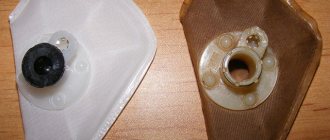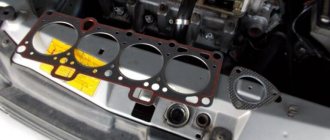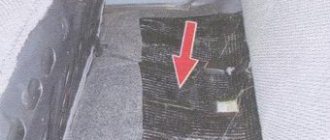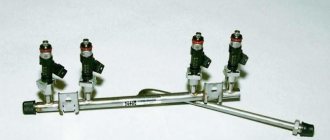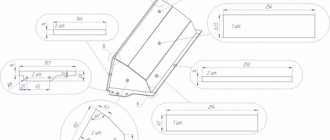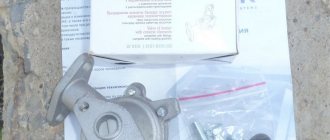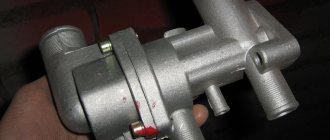Fuel supply system design
The fuel supply system of the Lada Vesta car consists of 5 parts:
- Gas tank with filling pipe. The gasoline tank is made of compressed plastic and is attached to the bottom of the car with two metal clamps. The filler neck is located on the right side of the Vesta. The plug has 2 valve mechanisms. One ensures the release of excess pressure created in the tank due to thermal expansion. The other serves to intake air, which fills the container when the liquid level in the gas tank decreases.
- Fuel module. Provides pumping of gasoline into the fuel rail. Consists of a fuel pump, bypass valve, gasoline level sensor and filter device.
- Injectors. Located on the ramp. Fuel is injected into the internal combustion chamber.
- Adsorber. The main component of the vapor recovery system. Located on the right side of the car, near the front fender. Equipped with a purge valve.
- Pipelines. Serve to transport fuel and gases between components of the fuel supply system.
Where is the fuel filter on the Vesta? Photo source: https://www.drive2.ru/l/527598181760894565
Unlike the design of the unit installed on previous AvtoVAZ models, the Vesta fuel filter is not portable. According to the manufacturer, the cleaner's lifespan is sufficient for the entire life of the vehicle. Sometimes cases of low-quality gasoline are poured in, which forces owners to replace the mesh in the Vesta filter.
Analogues of the Lada Vesta filter
If the entire unit needs to be replaced, then the Lada Vesta owner has no chance to save money. However, individual elements of the system can be replaced with cheaper analogues. For example, you can install a gasoline pump from the Japanese company AISIN, which will cost about 3,000 rubles. Installation of an electric fuel pump from a Kia Rio car, the price for which is 4,000 rubles.
Important: the analogues will have to be slightly modified in order for them to fit the Lada Vesta.
How much such work is worth at a reduced price - the car owner must judge for himself. It is believed that while there are no official analogues, it is better to replace the fuel module in a trusted service center and with an original one. Perhaps in the future this procedure will be simplified, or the part itself will become cheaper.
Article number and cost of the original fuel filter
The original Vesta filter element does not have an article number. On the open market, a mesh that performs rough cleaning can be found at a price of 165 rubles. Produces consumables. Under its logo you can find repair kits for the Lada Vesta fuel pump costing 950 rubles. The kit includes coarse and fine filtration devices, a pulsator tube and a lid (assembled).
Replacing the fuel filter. Photo source: https://www.drive2.ru/l/527598181760894565
In an official car service, they do not change individual components, but install a new unit. The catalog number of the fuel pump is 21800113900900. The cost of a new original unit averages 6,000 rubles.
Where is the fuel filter in Lada Vesta
The filter element, electric pump, like all other parts of the fuel module in the car are located behind the rear seat of the car, so in order to replace one of the parts of the module or the entire unit, car enthusiasts have to remove the rear seat cushions and soundproofing pads. The closest thing, namely right behind the pump inlet, is a coarse filter - a mesh - this is the only part of the entire unit that you can change yourself.
Manufacturers of Lada Vesta do not recommend replacing module components on your own, however, car enthusiasts have still found a way to disassemble and change filters without outside help.
When to change the fuel filter on Vesta
According to the manufacturer, the service life of the fine gasket is equal to the service life of the fuel pump. The fuel pump has a resource of 180 thousand kilometers. Photos on the Internet show dirty filter elements with more modest mileage figures.
On forums, car owners say that they change the fuel filter on their Vesta every 30-40 thousand km. The frequency of replacement is directly affected by the purity of the fuel used. When refueling at a suspicious gas station, the filter elements may become clogged within the first kilometers of driving.
Signs that replacement is needed
You can understand that the filtration device is clogged by some characteristic features of the machine’s behavior. These include:
- fuel pump noise;
- increased fuel consumption;
- reduction in engine power;
- car jerks when driving;
- floating idle speed;
- Difficulty starting the engine.
When the “Check Engine” light comes on and subsequent computer diagnostics, a clogged fuel filter displays error P0171.
Photo of the fuel filter on the Vesta. Photo source: https://www.drive2.ru/l/527598181760894565
These signs may also indicate other problems. But if the filter device was changed a long time ago, then you can start eliminating the problems by replacing it.
Factory filter Lada Vesta
A distinctive feature of the car is the combination of 2 cleaning parts in the fuel module: coarse and fine. Coarse cleaning is a mesh that can be changed. Fine cleaning is a paper filter element built into the module - accordingly, it can only be replaced with a fuel pump. Instead of separate filters, this model has a fuel module. Previously, cars were equipped with 1 small and cheap fine filter element, which stood at the bottom near the gas tank. The mesh was located under the seat in the fuel block. On Vesta, the part combines coarse and fine fuel filters and an electric fuel pump. Therefore, replacing one individual broken element is difficult. Typically, specialists replace the entire assembly, which significantly increases the cost of the operation.
When ordering a new fuel module, use part number 21800113900900 or 8450008680. In this case, you will receive a factory-made fuel assembly. Its price starts from 3500 rubles. At the same time, different stores may call the part differently: fuel unit, electric fuel pump module, electric fuel pump, electric fuel pump.
Part characteristics - The factory module of the Lada Vesta is a turbine-type electric fuel pump with a drainless fuel rail. The injectors that supply fuel are located in the intake pipe. The service life of the unit is higher than that of older versions of cars of this brand, but in the conditions of Russian realities, its replacement is required approximately every 180 thousand kilometers. They really say at the factory that it is designed for the entire service life of the car.
Self-replacement of the coarse fuel filtration device
The process of removing the gasoline pre-purification mesh on Vesta is more complicated than dismantling the filter on AvtoVAZ cars of other models. Difficulties arise from the fact that the unit is built into the fuel pump. A flathead screwdriver may be needed when working to remove the fuel pump.
Video demonstrating how to replace the fuel filtration element on a Lada Vesta:
How to remove
Step-by-step instructions on how to remove the Vesta fuel filter:
- Remove the back cushion of the sofa. The seat is secured with latches at the front and hooks at the back. Remove the interior soundproofing gasket to provide access to the pump cover.
- Rotate the cover protecting the fuel pump and remove it.
- Vacuum and wipe everything thoroughly so that dust and small debris do not get into the gas tank.
- Disconnect the fuel pump power terminal.
- Start the car and let it run until it stalls.
- Remove the terminal from the battery.
- Disconnect the fuel line.
- Turn the fuel pump retaining ring counterclockwise and remove it.
- Remove the element in the plastic case. You need to pull out the knot carefully, at a slight angle. Otherwise, the float sensor that determines the fuel level may be damaged.
- Carefully pull the lower part of the pump, where the Lada Vesta fuel filter is located, and remove it.
- Disconnect the drain pipe.
- Remove all the springs from the glass, marking which part was on which guide.
- Unclip the 3 latches and remove the fuel module.
- Pry up the spring holding the mesh and remove the coarse cleaning element.
Getting to the place where the fuel filter is located in the Vesta is quite difficult. You need to remove the components of the assembly very carefully, otherwise the process of replacing the mesh will result in the purchase of a new fuel pump.
How to install a new one
The fuel pump is assembled and installed in the reverse order. After completing the work, you need to bleed the fuel supply system. To do this, insert the ignition key into the lock and turn it a couple of times without starting the car. Then the car is started.
Replacing the air filter on Lada X-Ray
Preparatory stage:
- Rags;
- New Element: regular or carbon coated, depending on the modification and preferences of the car owner;
- Additional lighting if work is carried out in the dark;
- Flat head screwdriver.
Regulations for replacing a Lada X-Ray:
- We stop the car, turn off the engine, open the hood;
- Use a screwdriver to unclip the lid of the box where the Element is located;
- Remove the air filter X Ray;
- We wipe the cavity with a rag, clean it from dust, dirt, moisture;
- Place the new filter in the “Up Arrow” position;
- Snap on the plastic cover.
Just a few minutes and replacing the cleaner with XRAY is complete. Subsequent maintenance after 45,000 km. Of course, in conditions of increased dustiness, the interval can be reduced to 35,000 km.
First of all, read the operating instructions for your vehicle. The “Consumables” section indicates the type of Item. Most cars produced after 2015 are equipped with carbon filters, both in the cabin and in the air duct.
VAZ engine
- We bought a fuel filter and hose.
- We connect the mass to the body and to the filter housing.
- The filter housing was placed above the fuel pump and covered with double-sided tape.
- The standard filter in the electric fuel pump module was removed.
It was required: Bosch filter 0986450114 (496 RUR), fuel hoses to the ramp 2170 (405mm), power steering reservoir bracket 2110, bicycle tube.
The filter was installed on a bracket that is attached to the studs of the ABS block over the standard nuts. A strip of rubber from a bicycle inner tube was glued to the inside of the bracket to securely secure the filter to its lower part. Next we connect the fuel pipes:
The filter also acts as a pulsation damper (see information letter No. 25-18).
Replacing the fuel pressure regulator
- Remove the wire end from the fuel pressure regulator terminal.
- Remove the fuel pressure regulator spring clip by prying it off with a flat-head screwdriver.
- Remove the fuel pressure regulator from the module cover.
When reinstalling, apply a thin layer of engine oil to the O-ring.
Lada Xray. Replacing the fuel filter
In accordance with the maintenance regulations, we replace the fuel filter every 30 thousand km.
If the car is operated in dusty conditions or with low fuel quality, the filter must be replaced more often than specified in the regulations. We carry out the work on an inspection ditch or overpass.
The fuel filter is installed at the bottom of the vehicle in a recess in the underbody above the additional muffler for the exhaust system.
The fuel in the power system (with the ignition on and for some time after it is turned off) is under pressure. Therefore, if we replace the filter immediately after a trip or after turning on the ignition, it is necessary to relieve the fuel pressure in the power system. If the ignition has not been turned on for a day or more, there is usually no fuel pressure in the system. This can be checked by unscrewing the cap of the fuel rail fitting and pressing the spool rod (see “Power system”, page 123).
When replacing the filter, you need to take into account that it is located below the fuel tank and when the filter is removed, fuel can flow out of the tank by gravity through the disconnected tube. Therefore, we place a container under the filter to collect fuel.
To relieve pressure in the system, remove the lining of the left front side panel (see “Removing the controller,” p. 115).
By pressing the two latches, we disconnect the connection block between the engine management system wiring harness and the rear wiring harness.
We start the engine and let it idle until it stops due to fuel exhaustion. Then turn on the starter for 2-3 seconds. After this, the pressure in the power system will be released.
Using a 10mm wrench, loosen the tightening of the fuel filter clamp bolt.
Holding the fuel filter housing by the hexagon with a 19mm wrench, use a 17mm wrench to unscrew the fitting of the fuel supply tube to the filter.
We remove the tip of the tube from the filter and, in order to avoid fuel leakage from the tank, put the brake bleeder cap on the tip.
Similarly, we unscrew the fitting of the tip of the fuel supply tube to the ramp...
...and remove the tube tip from the filter.
We move the filter forward and remove it from the clamp.
Drain the remaining fuel in the filter into a container.
We install the new filter in the reverse order.
The arrow on the filter housing should be oriented in the direction of fuel flow (towards the front of the car).
Before connecting the fuel pipes to the filter, we check the condition...
... sealing rubber rings located on the tips of the tubes.
If the ring is damaged (tears, cracks, jams) or loses its elastic properties, replace the ring. After installing the filter, connect the connection block between the engine management system wiring harness and the rear wiring harness. Turn on the ignition and check the tightness of the connections.
Video on the topic “Lada Xray. Replacing the fuel filter"
How to replace the fuel filter for Lada Vesta
LADA XRAY 1.6 (2016): Replacing the cabin filter
Lada XRAY: do-it-yourself maintenance
When is it time to change
You can buy yourself a new TF literally as soon as you purchased the car from the showroom or took it from your hands. But after how long can it or should it be changed?
If you change the TF on a used car as soon as you re-register it, nothing bad will happen. It is not known what kind of filter was there before and how many kilometers it has already traveled and how long ago the previous owner changed it.
The frequency of TF replacement can vary significantly depending on a number of factors:
- vehicle condition;
- driving style;
- terms of Use;
- fuel system operation;
- the quality of repairs performed regarding the engine and fuel system;
- the quality of the gas stations where the previous owner of the used car refueled;
- engine's type;
- motor power, etc.
Only the specific instruction manual can answer you. And how often the TF changes depends on you specifically.
In general, I’ll tell you, many people believe that on diesel cars the TF is changed every 30 thousand kilometers, and on gasoline cars - from 60 to 100 thousand kilometers. And some automakers even say that the filter installed from the factory will last as long as the car itself.
Alas, these numbers are far from the truth. Why? It's simple. Ideal operating conditions are taken into account here. That is, smooth roads, high-quality fuel, measured driving style, and so on. Which of these do you have? Personally, I have problems on all counts, since driving on our roads in this way is impossible, even with a strong desire.
Therefore, the reality is that diesel filters are changed every 10-30 thousand kilometers, and gasoline filters - 20-60 thousand. Yes, there are exceptions when the car is rarely used, the driver is extremely careful and refuels at the best gas stations. Here the filter can really last 50-100, or even more than thousands of kilometers.
I will give one piece of advice that is far from bad. Take into account the mileage and compare it with the operating conditions of the vehicle. This way you will understand exactly how often you should change the TF.
A car is such an advanced invention that it itself will show signs indicating the need for replacement.
The machine says "It's time!"
There is a fuel sensor, engine temperature indicators, exhaust system, gas pedal responsiveness and other sources of information about the condition of the filter device.
When the car reports problems, the driver immediately changes consumables. After replacement, everything returns to its previous state and so on until the next service.
When to change? Then when the car displays the following:
- the engine runs unevenly, malfunctions are felt;
- when you press the gas pedal you feel a loss of power;
- fuel consumption increases sharply under normal operating conditions;
- smoke pours out of the exhaust pipe;
- Symptoms appear progressively.
Before changing the TF, be sure to look at the instruction manual, watch the video and determine exactly where the filter device is located specifically in your case.
In fact, replacing the filter yourself is not a problem in most cars. Although some withdrawals require the help of specialists. I don’t know why, it’s a mystery to me, but some automakers put filters in such deep and hard-to-reach places that it’s amazing. Apparently, this is specifically so that you contact a specialized car service center. I can’t find any other explanation for where the TF is located.
Another important issue is price. How much do you think TF costs? A little. There is no point in buying some super expensive filter for an inexpensive car. There are recommendations regarding the filter characteristics provided by the factory. Follow them. You can even compare a filter by photo and find exactly the same one for yourself if the previous one worked great, but its resource has already expired.
I hope the article was useful and accessible. Write your comments, leave reviews and ask questions. We will answer them.
Watch this video on YouTube
Subscribe, invite your friends and don't forget about us!
What does operating a clogged fuel purifier lead to?
The cleaners that are located on the Lada Vesta car are replaced if the resource is exhausted. If such actions are not performed, then:
- The performance of the power system and power unit is reduced. A clogged mesh does not clean the combustible mixture from foreign substances and impurities. Therefore, a low-quality combustible mixture enters the power unit.
- Rapid wear of probes, spark plugs, and accelerators. If an unpurified fuel mixture enters the corresponding components, it burns out partially. The sediment gets on the spark plugs and partitions. This leads to a reduction in service life.
- Fuel consumption increases. A vehicle that has a clogged filter requires more mixture to accelerate. Therefore, the driver spends more money on refueling.
- The motor does not start. At a certain stage, the power unit stops functioning. Restoring it will require significantly more money than purchasing a new filter.
Periodic replacement of the fuel purifier is something that every Lada Vesta owner should take care of. After all, this part affects the performance of the power supply system and power unit. Since the replacement procedure includes few steps, drivers can handle it too. It is not necessary to attend the workshop.
Share “Replacing the fuel filter on Lada Vesta”
